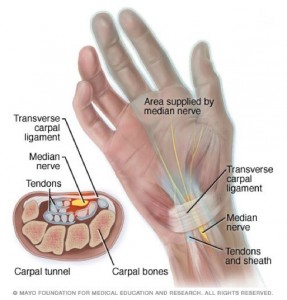-

Mayo Clinic Health Letter: Highlights from the August 2014 Issue
ROCHESTER, Minn. ― Here are highlights from the August issue of Mayo Clinic Health Letter. You may cite this publication as often as you wish. Reprinting is allowed for a fee. Mayo Clinic Health Letter attribution is required. Include the following subscription information as your editorial policies permit: Visit www.HealthLetter.MayoClinic.com or call toll-free for subscription information, 1-800-333-9037, extension 9771. Full newsletter text: Mayo Clinic Health Letter August 2014 (for journalists only). Full special report text: Mayo Clinic Health Letter Special Report August 2014 (for journalists only).
Hand pain not inevitable with aging
 Chronic hand pain and dysfunction aren’t inevitable aspects of aging, but hands are vulnerable to injury and degenerative conditions after years of wear and tear. The August issue of Mayo Clinic Health Letter includes an eight-page Special Report on Hand Pain, including common causes and strategies to alleviate, manage and even prevent hand pain.
Chronic hand pain and dysfunction aren’t inevitable aspects of aging, but hands are vulnerable to injury and degenerative conditions after years of wear and tear. The August issue of Mayo Clinic Health Letter includes an eight-page Special Report on Hand Pain, including common causes and strategies to alleviate, manage and even prevent hand pain.
Health concerns covered included arthritis, tendon and nerve conditions, trauma and infections. A primary care provider can treat and diagnose some hand conditions. Depending on the concern, a hand surgeon, rheumatologist, neurologist or rehabilitation specialist could be involved in treatment.
Here are some report highlights:
Surgery sooner for carpal tunnel. Carpal tunnel syndrome, one of the most well-known nerve compression syndromes, occurs when the median nerve becomes compressed or squeezed at the wrist. Symptoms can include burning, tingling and numbness. Infections, trauma or forceful repetitive activities often cause swelling, increasing pressure on the nerve. Contrary to popular belief, there’s little clinical data to prove that gentler repetitive activities, such as typing, cause carpel tunnel.
Wearing a brace and taking nonsteroidal anti-inflammatory medications may be the first course of treatment. If initial treatments aren’t helpful, surgery can relieve pain and prevent irreversible damage. Depending on the severity of symptoms, sometimes it is better to have surgery sooner rather than later.
Two types of arthritis. Arthritis, which literally means “inflamed joint,” occurs when normally smooth surfaces between the joints become irregular and no longer fit well together. Osteoarthritis is the most common form. It occurs when cartilage slowly wears down due to age or injury. In the hands, osteoarthritis most often develops at the base of the thumb and in the joints closest to the fingertips. The most effective treatment includes a combination of self-care, medication and, if needed, surgery.
Rheumatoid arthritis also commonly affects the hands. It occurs when the immune system turns on the body and attacks tissues enveloping the joints. Researchers believe that rheumatoid arthritis begins to damage joints within a year or two after beginning its course, which underscores the need for early diagnosis and treatment. A treatment plan would likely include rest, joint splinting and exercise combined with medications.
Natural remedies, complementary strategies offer symptom relief. Pain medications, while effective, have drawbacks including costs and side effects. Some natural remedies have shown promise in treating arthritis. One example is capsaicin, the substance that puts fire in hot peppers. Applied topically, capsaicin cream is effective in treating arthritis pain. Tai chi, acupuncture, yoga and massage may also reduce pain from arthritis.
Infections need care. Minor hand infections can quickly become devastating. The majority of people with acute hand infections are healthy adults who neglect or put off treatment of minor trauma. Bacteria, viruses and parasites can destroy healthy tissue, multiply and enter the bloodstream. A small scratch on the finger can potentially disable the hand. Chronic conditions including rheumatoid arthritis and type 2 diabetes can increase the risk of infections.
Larger waist size is important health risk
The August issue of Mayo Clinic Health Letter shares a compelling reason to keep waistlines trim ― research shows
that greater waistline circumference is linked to shorter life expectancy.
The new research, led by Mayo Clinic, showed this association even for people at a healthy weight for their height as measured by body mass index (BMI). The study analyzed data from 11 different studies that included health measurements of more than 600,000 people from around the world. Waist circumference was measured 1 inch above the navel. Participants were followed for a median of nine years.
Study findings included:
- Men with a waist circumference of 43 inches or greater had a 50 percent higher risk of death over the course of the study than did men with waists of less than 35 inches. This translated to about a three-year lower life expectancy after age 40.
- Women with a waist circumference of 37 inches or greater had an 80 percent higher risk of death over the course of the study than did women with waists of less than 27 inches. This translated to about a five-year lower life expectancy after age 40.
- Each 2-inch increment in waist circumference was associated with a 7 percent increase in the risk of death in men and a 9 percent increase in risk of death in women. This held true for people with a BMI that was normal, overweight or obese.
Researchers also found that modest or small decreases in waist circumference due to improved diet or physical activity could have important impacts in reducing health risks, even if total body weight didn’t change much.
New devices that track activity
An advanced generation of activity-tracking technology offers a much more accurate picture of daily movement and energy expenditures, according to the August issue of Mayo Clinic Health Letter. Many people overestimate their activity level. When they see their actual activity level, they often learn to increase activity habits.
Basic pedometers, the old technology, roughly estimate the number of footsteps taken in a period of time. The new gadgets, such as the Fitbit, Jawbone, Basis or Motoactv and the NEAT-certified trackers, take advantage of computer and electronics advances. They include accelerometers that detect movement and may have sensors that detect standing or sitting or elevation gain or loss. Data is crunched in microchips that can calculate and quantify movement. Devices can distinguish between types of movement based on acceleration and force. Although accuracy varies from product to product, most can distinguish between walking, jogging or taking stairs and, in some cases, bicycling.
Various other measures may include heart rate, body perspiration and body temperature. Some devices include a vibration that activates after a period of no activity. Often, the devices list progress toward a goal that might be 150 minutes a week of moderately intense activity, 10,000 steps a day or at least 10 minutes of activity every hour.
Devices typically have wireless download capability to smartphones, tablets or computers. The data is then displayed in graphs, charts and even comparisons to others who use the same device.
A basic pedometer costs $10 to $50. Newer devices sell for $60 to $200.
Over the long term, most people either quit using these tools or use them only sporadically. Still, it’s suspected ― though not proved ― that the initial education and guidance from the shorter-term use may be enough to kick-start healthy habits.
###
Mayo Clinic Health Letter is an eight-page monthly newsletter of reliable, accurate and practical information on today’s health and medical news. To subscribe, please call 1-800-333-9037 (toll-free), extension 9771, or visit http://www.HealthLetter.MayoClinic.com.
About Mayo Clinic
Recognizing 150 years of serving humanity in 2014, Mayo Clinic is a nonprofit worldwide leader in medical care, research and education for people from all walks of life. For more information, visit 150years.mayoclinic.org, http://www.mayoclinic.org andnewsnetwork.mayoclinic.org.
MEDIA CONTACT: Brian Kilen, Mayo Clinic Public Affairs, 507-284-5005, newsbureau@mayo.edu







